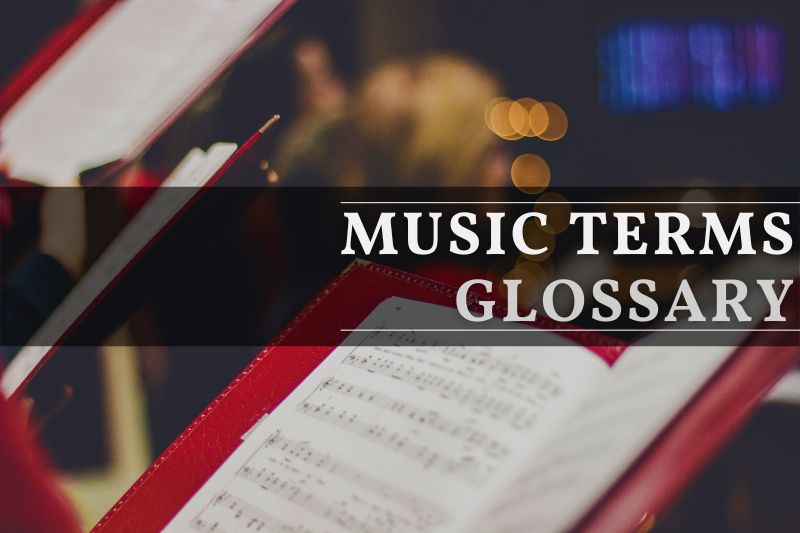Music Terms Glossary: List Of Basic Musical Terms

Have you always wanted to learn what the symbols and terms in your music sheet truly mean?
Learning the language of music can unlock a whole new depth of musical understanding. Understanding these terms can greatly enhance your appreciation and practice of music.
KEY TAKEAWAYS
Music terminology is an essential foundation for navigating through different music theory and composition elements, and I highly recommend it to all the beginner composers I talk to. Knowing the basics helps not only in interpreting complex rhythms and dynamics but also in reading sheet music effectively.
When I started studying music, learning musical terminology was a big part of what formed the foundation that eventually led to my full-time career as a music composer and producer.
Each term plays a crucial role in shaping your musical expression, from tempo indications that guide the speed and pacing to dynamics that convey the emotion and intensity.
Understanding these terms can transform your perspective on music, revealing the intricacy and passion embedded within each piece. Once you’re fluent in this musical language, you can truly appreciate all musical styles and periods.
Music Terms Glossary
Music terms are easier to understand and learn when you have some context. That’s why I’ve grouped them together below into categories. There are, of course, so many more, but it’s best to start with the basics and build up on that as your foundation.
This glossary is your guide to the most essential terms every musician, student, or music fan should know.
1. Tempo Terms
Tempo refers to the speed of a piece of music. These Italian terms are often found at the beginning of a score and dictate the pace:
- Adagio: Slowly and gracefully (literally, “at ease”).
- Allegro: Lively and fast.
- Andante: A moderate tempo, often described as “walking pace.”
- Presto: Very fast.
- Moderato: A medium, moderate speed.
2. Dynamics
Dynamics control the volume of a piece, shaping its emotional expression:
- Piano (p): Play softly.
- Forte (f): Play loudly.
- Mezzo Forte (mf): Medium loud.
- Crescendo (cresc.): Gradually get louder.
- Diminuendo (dim.): Gradually get softer.
3. Articulations
These markings guide how notes should be played:
- Staccato: Play notes short and detached, marked with a dot above or below the note.
- Legato: Play notes smoothly connected, often indicated by a curved line.
- Accent (> or ∧): Emphasize the note with extra force.
- Tenuto (-): Hold the note for its full value or slightly longer.
4. Musical Scales and Keys
Understanding scales is fundamental for musicians:
- Major Scale: A seven-note scale with a happy, bright sound.
- Minor Scale: A seven-note scale with a darker, somber tone.
- Chromatic Scale: A scale that uses every half step, including all 12 notes of an octave.
- Pentatonic Scale: A five-note scale common in folk and pop music.
- Diatonic: Scales that stay within the key signature, including major and minor scales.
5. Rhythm and Time
Rhythmic terms help define the structure of time in music:
- Time Signature: Found at the beginning of a piece, it tells you how many beats are in a measure (top number) and what type of note gets one beat (bottom number).
- Measure: A segment of time within a piece, divided by vertical lines on the staff.
- Eighth Notes: Notes played for half the duration of a quarter note, often grouped in twos or fours.
- Syncopation: Accents on the weaker beats or offbeats.
6. Harmony and Chords
Harmony adds depth and complexity to music:
- Chord: A combination of three or more notes played together.
- Chord Progression: A sequence of chords, often providing structure to a piece (e.g., I-IV-V-I).
- Consonance: Harmonies that sound stable and pleasant.
- Dissonance: Harmonies that create tension, often resolved later.
7. Forms and Structures
Musical form provides the roadmap for a composition:
- Ternary Form (ABA): A three-part structure where the first section returns after a contrasting middle section.
- Sonata Form: Common in classical music, it has three main sections: exposition, development, and recapitulation.
- Coda: A closing section that brings a piece to its conclusion.
8. Expression and Style
These terms shape the feel and mood of music:
- Rubato: Flexibility in tempo, allowing slight speeding up or slowing down for expressiveness.
- Cantabile: In a singing style, lyrical and smooth.
- Sforzando (sfz): A sudden strong accent.
- Marcato: Play the note forcefully and distinctly.
9. Instrument Families and Techniques
Understanding the instruments and how they are played enriches your appreciation of music:
- String Instruments: Violins, violas, cellos, and basses, played with a bow or by plucking (pizzicato).
- Woodwind Instruments: Flutes, clarinets, and oboes, producing sound through vibrating reeds or air columns.
- Keyboard Instruments: Pianos, organs, and synthesizers, played by pressing keys.
- Tremolo: Rapid repetition of a single note or alternating notes, often used in string and percussion instruments.
10. Common Italian and French Music Terms
Musical terminology often borrows from Italian and French to convey direction:
- Da Capo (D.C.): Return to the beginning of the piece.
- Dal Segno (D.S.): Return to a specific sign in the music.
- A Tempo: Return to the original tempo.
- Largo: Broadly and slowly.
- Vivace: Lively and brisk.
Basics of Music Theory
Understanding the basics of music theory is important for any artist, musician, composer or songwriter who wants to take their craft to the next level. Music theory involves exploring musical notation, scales, keys, rhythm, and time signatures. These elements form the foundation upon which music is built, providing the tools necessary for reading, writing, and performing music effectively.
Musical Notation
Musical notation is the written language of music. It uses symbols to represent sound and silence, conveying the pitch, duration, and intensity of notes. Notes and rests are placed on a staff consisting of five lines and four spaces. Each position corresponds to a different pitch.
A clef at the start of the staff indicates the pitch range, with the treble and bass clefs being the most common.
Ledger lines extend the range of the staff for pitches outside its normal limits.
Key signatures indicate the piece’s key by showing which notes will be played sharp or flat throughout.
To fully understand a piece, you must also look at the time signature, which reveals how many beats are in each measure and what note value is assigned to one beat.
Scales and Keys
Scales are sequences of notes arranged in ascending or descending order, forming the basis of a musical composition.
The major scale is often considered happy or bright, while the minor scale tends to be more somber or serious.
Chromatic scales use every semitone, presenting all twelve pitches within an octave.
Pentatonic scales, typically with five notes, are common in many musical traditions due to their simplicity and melodic sound.
To determine the tonality of a piece, you look at its key signature, which establishes the home scale and tonic note. Diatonic scales use seven notes and are a staple in Western music, encompassing both major and minor scales. Understanding these scales and keys helps you grasp the mood and structure of a musical work.
Rhythm and Time Signatures
Rhythm is the aspect of music that deals with timing. It involves the duration of notes and rests and their placement within a piece.
Beats are the basic units of time, and they are grouped by measures as specified by the time signature.
A time signature appears at the beginning of a piece of sheet music after the clef and key signature. It consists of two numbers: the top number indicates how many beats are in a measure, while the bottom number tells which note value counts as one beat.
Common time signatures include 4/4, familiar in many styles, 3/4 for waltzes, and 6/8, often found in compound meter tunes.
Recognizing and interpreting these elements will enhance your ability to perform and appreciate music accurately.
Elements of Composition
Creating music involves several crucial elements contributing to a piece’s unity. These elements, including melody, harmony, and form, each play a vital role in shaping a musical composition.
Melodic Structures
When crafting a melody, the focus is on creating sequences of notes that become memorable phrases. These phrases work together in a musical piece to form larger structures and themes.
Musical phrases act like sentences, providing a sense of progression and completion. You might think of melodies as the tune you hum that catches your ear. They’re essential to expressing emotion in music.
Whether in classical sonata form or a simple pop song, melodic structure is vital. It guides listeners through the emotional landscape of the composition, making each piece distinct and engaging.
Harmonic Progressions
Harmony adds depth and richness to music by combining notes, known as chords. Chords are formed by playing multiple notes together, creating a fuller sound.
In harmonic progressions, these chords move in a sequence, setting the emotional tone of a piece. Chord progressions like I-IV-V-I are typical in many genres, providing a familiar path for listeners to follow.
These progressions aren’t just about moving from one chord to another; they give the music emotional depth, from tension to resolution. Whether listening to a pop song or a classical symphony, harmony stitches the elements into a cohesive whole.
Form and Structure
The organization of a musical composition into different sections is known as its form. Common forms like ternary (ABA) or sonata form dictate how themes and ideas are developed.
Form helps you understand a piece’s layout and how the music evolves. It’s like a blueprint that guides the composer and the listener from start to finish.
Form dictates repetition and variation in a piece of music, ensuring that important themes are revisited while new ones are introduced. Whether simple or complex, the form gives music its framework, allowing composers to explore and express ideas creatively.
Reading Sheet Music
The Grand Staff
The grand staff comprises the treble and bass clefs, functioning as a framework to display musical notes for different pitches. Sheet music combines these staffs to provide a complete representation of a piece, covering the entire pitch range.
The treble clef sits on the upper lines, often used for higher-pitched instruments or the right hand on the piano. Meanwhile, the bass clef appears below, signaling pitches for lower instruments or the left hand on the piano.
Each staff is divided by vertical lines into measures, containing a specific number of beats dictated by the time signature.
Clefs and Pitch
Clefs are symbols that determine the pitch of written notes, with the most common being the treble and bass clefs.
The treble clef is used for notes above middle C, aligning its curl around the G line, while the bass clef centers its dot around the F line. These guides help you identify notes across the grand staff with precision.
Understanding how clefs set note positions lets you read pitches accurately. For example, a quarter note on the second line of the treble clef is a G.
Dynamic and Expressive Marks
Dynamic and expressive marks in sheet music instruct on the volume and character of how notes should be played. They range from piano (p) for soft volume to forte (f) for loud.
Additional markings appear as scripts like crescendo for gradually increasing volume or staccato dots indicating short, detached notes. These symbols guide you to convey specific emotions and energies in your performances.
Expressive marks enrich musical interpretation, transforming ordinary notes into impactful musical expressions. Integrating these nuances elevates a basic score into a compelling auditory experience.
Tempo and Dynamics
Understanding Tempo
Tempo indicates how fast or slow a piece of music should be played. It is often specified at the beginning of a score using Italian terms like allegro for fast or adagio for slow.
These terms help you gauge the speed alongside markings like beats per minute (bpm). Commonly seen is common time, which means 4/4, but you might encounter different time signatures like duple meter (2/4) that affect how you count the music.
Dynamic Range and Markings
Dynamics in music involve variations in volume, from soft (piano) to loud (forte). These dynamic markings guide you in controlling the intensity of a piece.
Pianissimo (pp) indicates very soft, while fortissimo (ff) means very loud. The range of dynamics helps convey the emotional content of the music. Using these markings, musicians express the story or mood intended by the composer.
Gradual Changes in Music
Sometimes, dynamics and tempo can change gradually within a piece. Terms like crescendo and diminuendo show a gradual increase or decrease in volume. S
imilarly, accelerando and ritardando indicate a gradual increase or reduction in tempo. These elements often appear in slow movements to effectively build intensity or calmness. Understanding and mastering these gradual shifts lets you beautifully shape the musical narrative.
Types of Musical Works
Solo and Ensemble Pieces
Solo and ensemble pieces offer varied musical expressions. Solo instruments like the piano or violin allow you to highlight individual artistry. Personal interpretation is important here! The technically most perfect performance will never compare to an interpretation by a creative artist.
In contrast, ensemble pieces bring musicians together. Chamber music, often played by small groups, offers a nuanced interaction of parts, each voice contributing to a harmonious whole.
Ensemble compositions include string quartets or wind quintets, creating a rich tapestry of sound through collaboration rather than individual showmanship.
Vocal and Instrumental Genres
Vocal works range from the simplicity of a cappella performances to the grandeur of operas. In these compositions, the performer’s voice melds with music, telling stories or conveying emotions in a way that resonates deeply with listeners.
Instrumental pieces communicate rich narratives and moods without vocals. Orchestral music, for example, combines various instruments in symphonies or symphonic poems, creating expansive soundscapes that evoke vivid imagery through carefully crafted musical themes.
Evolution of Musical Forms
Musical forms have transformed significantly over time. Early music often showcased simpler structures, while the Baroque period introduced complex counterpoint and ornamentation. Beethoven’s contributions during the Classical era brought substantial development in the form of symphonies and sonatas.
As time progressed, new expressions emerged, like the tone poem, a single-movement work that uses music to illustrate a narrative or evoke a particular atmosphere. Understanding these evolutions helps you appreciate both the historical context and innovative spirit that continue to define music today.
Instruments and Voices
Instrument Families
Musical instruments are typically grouped into families based on their sound production methods:

Strings
ike the violin and guitar, string instruments produce sound through vibrating strings. The instrument’s body amplifies the sound, with pitch controlled by finger placement or string tension.
Played by plucking, strumming, or bowing, strings bring a wide range of tones, from soft and delicate to rich and powerful, making them versatile across musical genres.

Woodwinds
Woodwind instruments like the flute and clarinet create sound by blowing air through a reed or across an opening. Pitch is altered by opening or closing holes along the instrument’s body.
Known for their expressive and melodic qualities, woodwinds add depth and nuance to ensembles and solo performances alike.

Brass
Brass instruments, such as the trumpet and trombone, produce sound through the vibration of the player’s lips against a cup-shaped mouthpiece. These instruments amplify the buzzing sound via long, coiled metal tubing, with valves or a slide used to change pitch.
Known for their bold, resonant tones, brass instruments add power and brilliance to any musical ensemble.

Percussion
Percussion instruments, like drums and cymbals, produce sound when struck, shaken, or scraped. Some, like xylophones, are tuned for melody, while others, like tambourines, focus on rhythm.
Percussion adds energy and texture to music, from driving beats to subtle accents.
Each family brings distinct voices and characters to an ensemble, making them essential in creating rich musical textures.
The Human Voice
The human voice is a versatile instrument capable of various tones and expressions. Solo voices can be categorized into different ranges, such as soprano, alto, tenor, and bass, each bringing its unique quality to choral and solo performances.
Vocal technique is crucial for singers, focusing on breath control, pitch accuracy, and dynamic expression. When you sing, you’re not only producing notes but conveying emotion and storytelling, which adds a deeply personal aspect to music. Combining multiple voices, choral singing can create powerful harmonies and is often used in genres ranging from classical to pop.
Historical and Modern Instruments
Musical instruments have evolved significantly over time. In ancient times, instruments like lyres and flutes were prominent. The Baroque period introduced us to harpsichords and early stringed instruments, while the Classical period gave rise to the modern piano and orchestra configuration.
Contemporary music often blends traditional instruments with electronic ones, creating new soundscapes. Instruments like electric guitars and synthesizers have reshaped how you experience music today. Understanding this evolution helps you appreciate the rich tapestry of sounds that form modern music, connecting the past with the present through innovative creations.
Musical Styles and Periods
Classical and Romantic Eras
The Classical Period (c. 1750-1820) is known for balanced structures and emotional restraint. Notable composers like Mozart and Haydn epitomize this era with their symphonies and operas. This period emphasized clarity and balance in composition, a response to the complex textures of the preceding Baroque Period.
Transitioning to the Romantic Era (c. 1820-1900), music became more expressive and emotive, reflecting broader artistic trends of the 19th century. Composers like Beethoven and Chopin championed individualism, often infusing their works with heroic themes and expansive orchestrations. The focus shifted from strictly structural compositions to pieces that evoked mood and conveyed deep personal sentiments.
Folk and Popular Music
Folk music represents cultural expressions passed down through generations, often orally. It is deeply rooted in community traditions and reflects the social histories of diverse groups. Unlike more formal genres, folk music embraces simplicity and connection.
Popular music, evolving rapidly in the 20th century, encompasses myriad styles influenced by social and cultural changes. It is accessible and widely accepted, often characterized by rhythms and melodies that resonate broadly. This category includes genres like rock, jazz, and pop, which shaped cultural landscapes with their innovative soundscapes.
Contemporary and Experimental
In Contemporary music, boundaries are intentionally pushed. With influences from both Western music tradition and global styles, new works often merge classical techniques with innovative sounds.
Experimental music explores unconventional methods and atonal elements, often breaking away from traditional harmonic structures. Figures like Arnold Schoenberg pioneered atonal music in the early 20th century, challenging listeners with sounds that defy familiarity. This pursuit of novel musical experiences continues today, reflecting the ever-evolving nature of artistic creativity.
Music in Practice
Performing Music
When performing, you translate music notation into sound. The better you understand the pitch of the notes and rhythmic patterns in a composition, the better your performance, and that’s where the importance of understanding all the musical terms comes in. Your focus on the music’s nuances facilitates a connection between the composer, your performance and the audience.
Practice and repetition are essential to performing effectively, and executing dynamics and articulations accurately are vital to bringing pieces to life. Ultimately, performance is about conveying emotion and engaging with those who listen.
Improvisation and Interpretation
Improvisation is a dynamic practice where you build music spontaneously, while interpretation revolves around personal expression. These elements encourage you to dissect a piece deeply and explore its nuances.
Techniques like theme variation and harmonic exploration are common in improvisation. Meanwhile, interpretation lets you shape each performance, considering the composer’s intentions and adding your variations. Both improvisation and interpretation allow you to make every performance unique and memorable.
Understanding Harmony
Chords and Progressions
Chords are the foundation of harmony. They are created when you play multiple notes simultaneously. I won’t get into too much detail here as it’s a whole another series of articles to cover the complexity of chords and harmony!
On a basic level, you should start by studying the major and minor chords.
A sequence of chords or chord progressions provides the framework for constructing melodies in music. The I-IV-V-I progression is a classic example in Western music. This progression moves from the tonic chord to other chords within a key, producing movement and resolution. Recognizing chord progressions enhances your perception of the music’s emotional arc.
Consonance and Dissonance
Consonance and dissonance refer to the quality of intervals and chords. Consonant harmonies are stable and pleasant, like a major chord, while dissonant harmonies create tension with pitches that clash.
As a composer, I always use consonance and dissonance and work to balance these elements in music to engage listeners. Too much dissonance will make the composition tiring, but when applied tastefully, it can elevate it and help communicate the detailed emotions and timber.
Resolving dissonant sounds guides the listener through tension and release. Recognizing these shifts allows you to understand the emotional gestures in a piece of music and how to master them for use in your compositions.
Voice Leading and Counterpoint
These are also topics on which I could write a whole series of articles! But for all intents and purposes, I will touch this on the surface level.
Voice leading is the technique of moving individual melodic lines, or voices, to create smooth and cohesive harmony. It involves efficiently guiding each voice to its next pitch, maintaining a logical flow.
Counterpoint is the art of combining different melodic lines that are independent yet harmonically interdependent.
Consider the basso continuo in Baroque music, where a continuous bass line supports a complex interplay of higher melodies.
By analyzing voice leading and counterpoint, you can gain insight into musical works’ intricate structure and creativity.
Musical Notation Symbols
Notation for Pitch and Duration
Musical notation uses a staff of five horizontal lines to depict pitch. Clefs determine the pitch range: the treble clef for higher notes and the bass clef for lower ones. Notes are placed on lines and spaces to indicate pitch, with stems and flags modifying their duration.
Italian words, such as largo or allegro, denote tempo, affecting how the notes are timed. Time signatures are placed at the staff’s beginning to indicate the meter and how many beats each measure, or bar, contains. The bar line marks the end of each measure, helping to organize the rhythm.
Articulation and Phrasing
Articulation symbols show you how to perform individual notes or passages. Staccato is shown with a dot and indicates short, detached notes, while a legato marking, often a curved line, means the notes should flow smoothly together.
Accents, expressed with a “>” or “∧” above the note, signal that it should be played more forcefully.
Phrasing uses curved lines over a sequence of notes to suggest a musical sentence, hinting at expressive playing.
Repeats and Codas
Repeats are commonly marked with double bar lines and dots facing the direction to be repeated. They let you loop sections of music, simplifying the score. Commonly seen Italian and French terms, like da capo (D.C.) and dal segno (D.S.), instruct you to return to previous sections.
A coda is a special passage that closes a piece, often marked with a unique symbol. It’s the final path in navigating complex compositions, ensuring the performance aligns with the composer’s vision. Look for these cues to maintain musical coherence.
Conclusion
By learning about musical terms, you’ve taken an important first step on your way to a whole new understanding of how to communicate musical expression. Concepts like the chromatic scale, the nuances of dynamic instruction, and the structure of musical forms deepen your ability to appreciate music and equip you to create, perform, and interpret it in powerful ways.
In my career as a composer and producer, mastering these terms opened countless doors for me to express musical ideas and connect with others.
Whether deciphering the notes of a chord in an orchestral composition or experimenting with a fast tempo on a keyboard instrument, each discovery brings you closer to the heart of music.
Frequently Asked Questions
What do different musical dynamics indicate in sheet music?
Musical dynamics indicate the volume at which music is played. Terms like piano (soft) and forte (loud) tell you how quiet or loud to perform. Symbols such as crescendo (gradually getting louder) or diminuendo (getting softer) provide further nuances to the piece’s emotional expression.
Can you explain the structure of a typical sonata form?
The sonata form typically consists of three main sections: exposition, development, and recapitulation.
The main themes are introduced in the exposition. The development explores these themes in various ways, often leading to modulation. The recapitulation returns to the original themes, typically in the home key, providing resolution.
How do tempo markings affect the pace of a piece?
Tempo markings set the speed of a piece.
Terms like Allegro (fast) or Adagio (slow) offer guidance on how quickly the music should be played. Depending on the composer’s intentions, these instructions impact the mood, creating urgency or calmness.
What common symbols are found in music notation, and what do they mean?
Common symbols in music notation include the treble and bass clefs, which indicate the pitch range. The sharp, flat, and natural signs alter pitch, while rests denote silence.
Time signatures tell you how many beats are in a measure, and key signatures establish the tonal center.
Could you outline the various musical textures and their characteristics?
Musical textures describe how different voices or instruments interact.
Monophonic texture involves a single melody line. Polyphonic texture combines multiple independent melodies. Homophonic texture features a main melody supported by chords, creating a rich harmonic sound.
What does each of the 12 musical keys represent in composition?
Each of the 12 musical keys offers a distinct tonal color and emotional effect.
For instance, C major is often perceived as bright and clear, while D minor might evoke a more somber or dramatic mood. Composers use these keys to convey specific emotions and atmospheres within their music.





